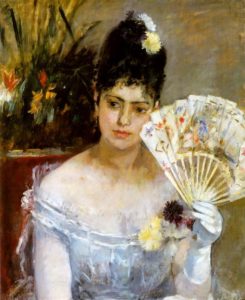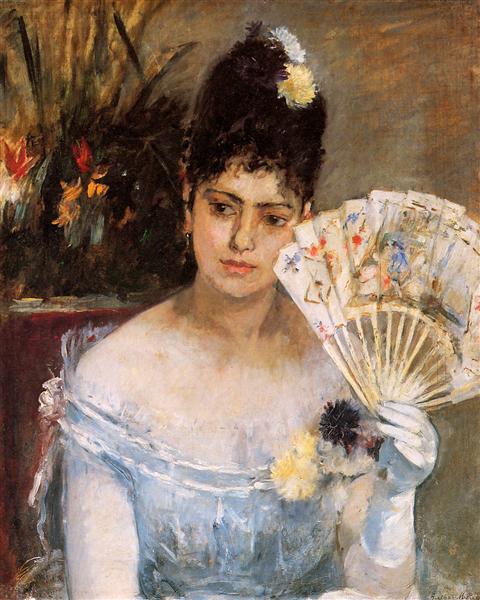When choosing a cover for my novel, La Luministe, I wanted to convey the beauty of Berthe Morisot’s painting, but I also wanted to suggest something about the artist herself. The brown-eyed brunette beauty in the painting in At the Ball is not Berthe Morisot, although the artist seems to have intentionally chosen a model who resembles her. (Morisot used the same model in Before the Theater, in which she is dressed in Morisot’s own black gown.) The model is only known to us as “Mademoiselle M,” which furthers the parallel between her and Mademoiselle Morisot.
But there the resemblance ends. Morisot has painted her model wearing a lovely evening gown, gloves, and dangling earrings. She is adorned with flowers in her hair and at her neckline, with the flowers on her fan and the plants behind her creating a floral wreath around her. But Morisot herself shied away from social occasions and preferred to dress simply, in only black or white. Why then did she choose to paint a woman at a ball?
One reason was that by the year she created this painting, 1875, Berthe Morisot had helped found the Impressionist movement and was already preparing for the group’s second exhibition. One of the tenants of Impressionism was to show modern life, rather than historical battles or Biblical scenes. While it would have been improper for Morisot to frequent the cafés where artists drank and argued about art late into the night, or circuses, or café-concerts where singers sang risqué songs, upper-class women were free to attend the opéra and balls. So for women like Morisot, At the Ball filled the bill. The artist has depicted modern life without having to participate in it.
Aside from entertaining guests in her home and attending dinners at the homes of close friends, Morisot lived a rather secluded life. In fact, she may have actually painted this work in her home, as the foliage in the background resembles the indoor garden seen in another of Morisot’s paintings. In Interior, a woman lost in thought sits in front of the same garden. Morisot’s model is sitting on a sofa or chair suggesting a ladies’ rest area, set off from the bustle of the ball by a barrier of large potted plants.
Morisot’s portraits are all part of her “search for distilled womanhood”. To her, that was a woman’s inner life. In At the Ball, she pursues this search in a very public context. Yet the model, separated from the noise and excitement of the ball, watches all that is going on. Are we witnessing a candid moment, or one that is highly calculated?

Another possibility is that the young woman is discreetly communicating with a gentleman through the language of the fan. In an era when a higher social class dictated that women’s interactions with men be limited, women could still convey messages via this useful accessory. The young woman in this painting holds an open fan in her left hand, conveying a specific (and decorous) message: “come and talk to me. ”
But we are looking at a static image. If this woman has just finished slowly opening the fan, her message is, “wait for me. ” If she has been fanning herself quickly, she’s told her admirer, “I am engaged”, while slow fanning meant, “I am married. ” Moving the fan with her left hand meant, “they are watching us”. For the bolder mademoiselle, letting the fan slide on her cheek meant, “I want you. ” But holding the fan still on her left cheek was a clear, “NO. ”
Like many Impressionist paintings, At the Ball did not sell. When Berthe Morisot and her husband, Eugène Manet built a new home on the rue Villejust, she chose this exquisite painting to adorn their dining room. How appropriate for a woman who preferred to stay at home. But this homebody, who chose to focus her energy on her work rather than society has quite as much of a story to tell as does the woman at the ball.
Just as the woman At the Ball hopes to lure her admirer to her side, I hope that she entices you to read La Luministe: Berthe Morisot, Painter of Light.
